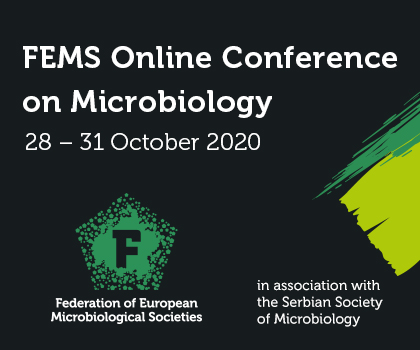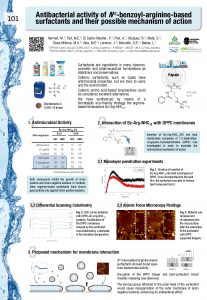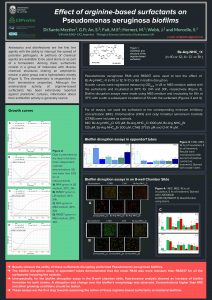El Simposio de Jóvenes Microbiólogos (Young Microbiologists Symposium) organizado por la Universidad de Southampton (Reino Unido) tuvo lugar en forma virtual entre los días 26 y 27 de agosto del 2020. En este evento, la Dra. Susana Morcelle y su grupo de investigación ganaron el premio en la categoría de presentación de póster con el trabajo Antibacterial activity of Nα-benzoyl-arginine-based surfactants and their possible mechanism of action.
En el evento, el CIProVe participó con la presentación de dos trabajos pertenecientes a las líneas de investigación de las Dras. Morcelle y Bakas, exponiendo los avances del grupo en el estudio de la actividad antimicrobiana y el mecanismo de acción de tensioactivos derivados de arginina sintetizados por el grupo. En el trabajo encabezado por la Dra. Paula Di Santo, los investigadores pusieron en evidencia la actividad de los compuestos sintetizados frente a biofilms de Pseudomonas aeruginosa, en un trabajo realizado e colaboración con la Universidad de Southampton durante una estancia realizada en dicha institución por la Dra. Di Santo. Por otro lado, la Lic. Melisa Hermet compartió parte de la investigación de su trabajo de tesis doctoral, profundizando en el estudio de la interacción de los mencionados tensioactivos con sistemas modelo de membranas como parte de la elucidación del mecanismo de actividad antimicrobiana de los compuestos.
A contiuación les compartimos la nota realizada a la Dra. Morcelle por la Federación Europea de Sociedades de Microbiología (FEMS):
What is your current position and what was your scientific journey to get there?
Since 2008, I am a member of the CONICET (Comisión Nacional de Investigaciones Científicas y Técnicas, National Council of Scientific and Technical Research) Researcher Career. My first step in the scientific research journey began with my doctoral thesis, which I carried out at the Plant Protein Research Center (Centro de Investigación de Proteínas Vegetales, CIProVe-Centro Asociado CICPBA-UNLP), belonging to the Faculty of Exact Sciences of the National University of La Plata (Argentina). My thesis work was on the purification and characterization of a peptidase from the latex of a native Argentinean plant species and its application as a biocatalyst in peptide synthesis reactions.
I carried out my postdoctoral work between CIPROVE and the Department of Peptides and Proteins of the Institute of Chemical and Environmental Research (IIQAB-CSIC, today IQAC-CSIC, Barcelona, Spain), internalizing myself in the aspect most related to the use of enzymes in biocatalysis under the direction of Dr. Pere Clapés. Since then, I have been interested in using enzymes for the generation of compounds of interest in the health area or using them in various industrial processes. The underlying idea in these investigations is the development of eco-friendly strategies to obtain valuable compounds or the design of processes of possible application in pharma industry or biorrefineries. Now, I am devoted to the development of amino acid-based compounds with surface activity obtained by biocatalytic means, as well as their physicochemical and biological characterization. And, as in a typical journey, there are some secondary paths I explore in collaboration of other colleagues, as the study and potential application of plant latex lipases as biocatalysts in esterification and transesterification reactions. All my research takes place in the CIProVe, where I am the head of a group of young researchers, PhD students and post doc fellows without whom all these investigations wouldn’t be possible.”
Could you describe the research your poster covered?
The research covered by my poster focuses on how one of those compounds that we obtained by a condensation reaction catalyzed by the plant protease papain: an arginine derivative with a benzoyl moiety linked to its α-amino group and an hydrophobic lineal alkylamine of ten carbons forming an amide bond with the amino acid α-carboxyl group. The resulting compound (Bz-Arg-NHC10) has a typical amphiphilic structure, since it bears an hydrophilic head with a positive net charge — the guanidine group of the arginine residue — and a long hydrophobic tail — provided by the alkylamine. The structure of Bz-Arg-NHC10 resembles to that of the quaternary ammonium salts (or Quats), a family of cationic surfactants with a well known antimicrobial activity. However, Quats are usually toxic and have a low biodegradability, whereas amino acid-based surfactants can be considered more similar to natural surfactants (biosurfactants), or other natural molecules as antimicrobial peptides or lipopeptides. When tested against different bacterial strains, Bz-Arg-NHC10 showed an interesting antimicrobial activity, demonstrating a similar efficiency against gram-positive and gram-negative bacteria, whereas other arginine-based surfactants had biocidal effect against gram-positives whereas they are bacteriostatic against gram-negatives.
Since surfactants are known to interact with biological membranes, we hypothesize that the bacteria membrane could be the main target of the biocidal activity of Bz-Arg-NHC10. To this aim, we performed some studies in order to characterize the interaction of our compound with a synthetic model membrane composed by 1,2-dipalmitoyl-sn-glycero-3-phosphocholine (DPPC). From these studies (monolayer penetration experiments, differential scanning calorimetry, and atomic force microscopy observations) we conclude that the surfactant could disturb the DPPC membrane and extracted its lipids by the formation of mixed micelles. Although more assays with other model membranes should be made, these preliminar results would indicate that the benzoyl group attached to the polar head of Bz-Arg-NHC10 would increase the hydrophobicity of the molecule: this special feature would be the responsible of the the biocidal activity against gram-negatives demonstrated by this compound when compared with other arginine-based ones. ”
What do you hope to focus your research on in the future?
The idea is to explore the ability of hydrolases as biocatalysts in the generation of this kind of compounds, based in other amino acids and other alkyl amines or alcohols, as to follow the trend of finding eco-friendly technologies for sustainable production of valuable fine chemicals. We’re also interested in testing them as antimicrobials, study their mechanism of action, evaluate their toxicity and find an interesting application as antiseptics as part of a formulation, may be for human use —as in products for personal care like mouthwash solutions, for example — or as disinfectants of surfaces or fomites in hospitals —for cleansing surgical material, or prostheses, among others. ”
Nota extraída del sitio web Federation of European Microbiological Societies



